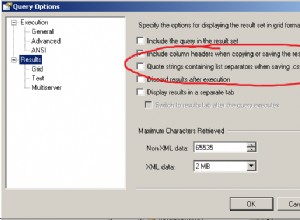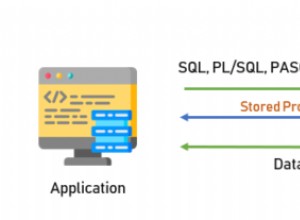Istnieją dwa sposoby wykonania PIVOT statyczne, gdzie na stałe zakodujesz wartości i dynamiczne, gdzie kolumny są określane podczas wykonywania.
Nawet jeśli będziesz potrzebować wersji dynamicznej, czasami łatwiej jest zacząć od statycznego PIVOT a następnie pracuj nad dynamicznym.
Wersja statyczna:
SELECT studentid, name, sex,[C], [C++], [English], [Database], [Math], total, average
from
(
select s1.studentid, name, sex, subjectname, score, total, average
from Score s1
inner join
(
select studentid, sum(score) total, avg(score) average
from score
group by studentid
) s2
on s1.studentid = s2.studentid
) x
pivot
(
min(score)
for subjectname in ([C], [C++], [English], [Database], [Math])
) p
Zobacz SQL Fiddle z demonstracją
Teraz, jeśli nie znasz wartości, które zostaną przekształcone, możesz użyć do tego dynamicznego SQL:
DECLARE @cols AS NVARCHAR(MAX),
@query AS NVARCHAR(MAX)
select @cols = STUFF((SELECT distinct ',' + QUOTENAME(SubjectName)
from Score
FOR XML PATH(''), TYPE
).value('.', 'NVARCHAR(MAX)')
,1,1,'')
set @query = 'SELECT studentid, name, sex,' + @cols + ', total, average
from
(
select s1.studentid, name, sex, subjectname, score, total, average
from Score s1
inner join
(
select studentid, sum(score) total, avg(score) average
from score
group by studentid
) s2
on s1.studentid = s2.studentid
) x
pivot
(
min(score)
for subjectname in (' + @cols + ')
) p '
execute(@query)
Zobacz Skrzypce SQL z wersją demonstracyjną
Obie wersje przyniosą takie same wyniki.
Aby uzupełnić odpowiedź, jeśli nie masz PIVOT funkcji, możesz uzyskać ten wynik za pomocą CASE oraz funkcja agregująca:
select s1.studentid, name, sex,
min(case when subjectname = 'C' then score end) C,
min(case when subjectname = 'C++' then score end) [C++],
min(case when subjectname = 'English' then score end) English,
min(case when subjectname = 'Database' then score end) [Database],
min(case when subjectname = 'Math' then score end) Math,
total, average
from Score s1
inner join
(
select studentid, sum(score) total, avg(score) average
from score
group by studentid
) s2
on s1.studentid = s2.studentid
group by s1.studentid, name, sex, total, average
Zobacz Skrzypce SQL z wersją demonstracyjną




